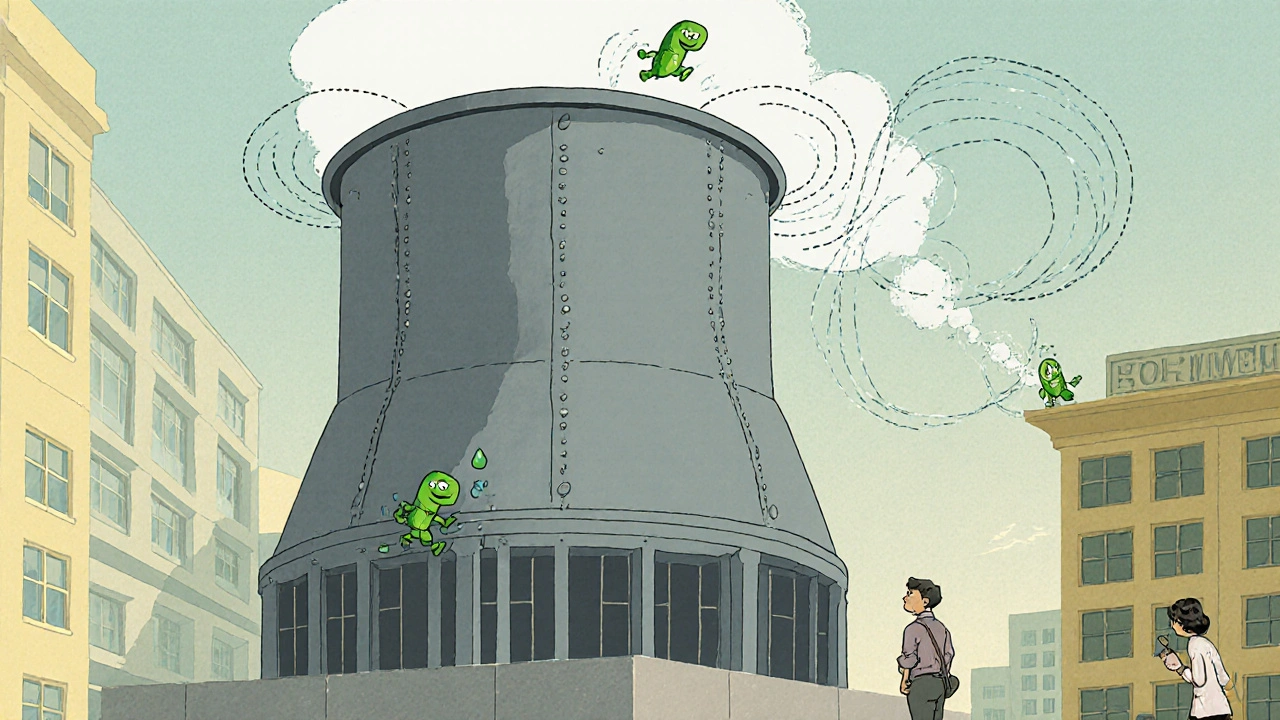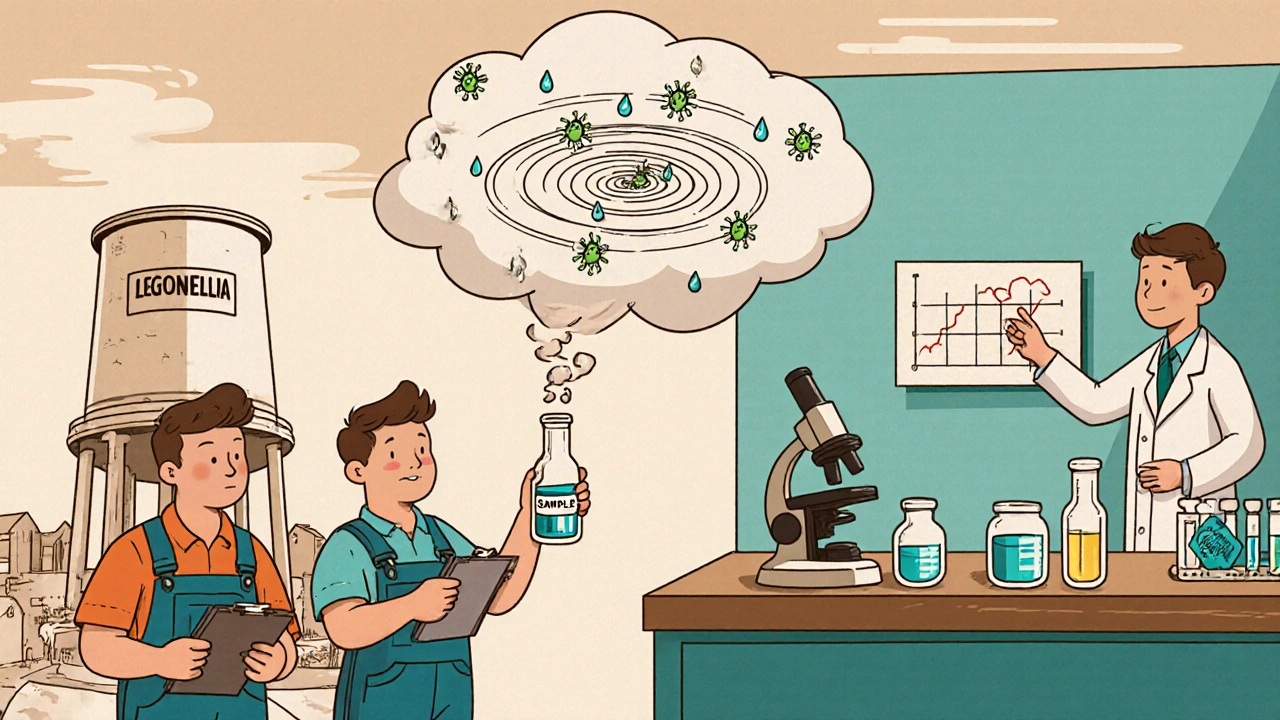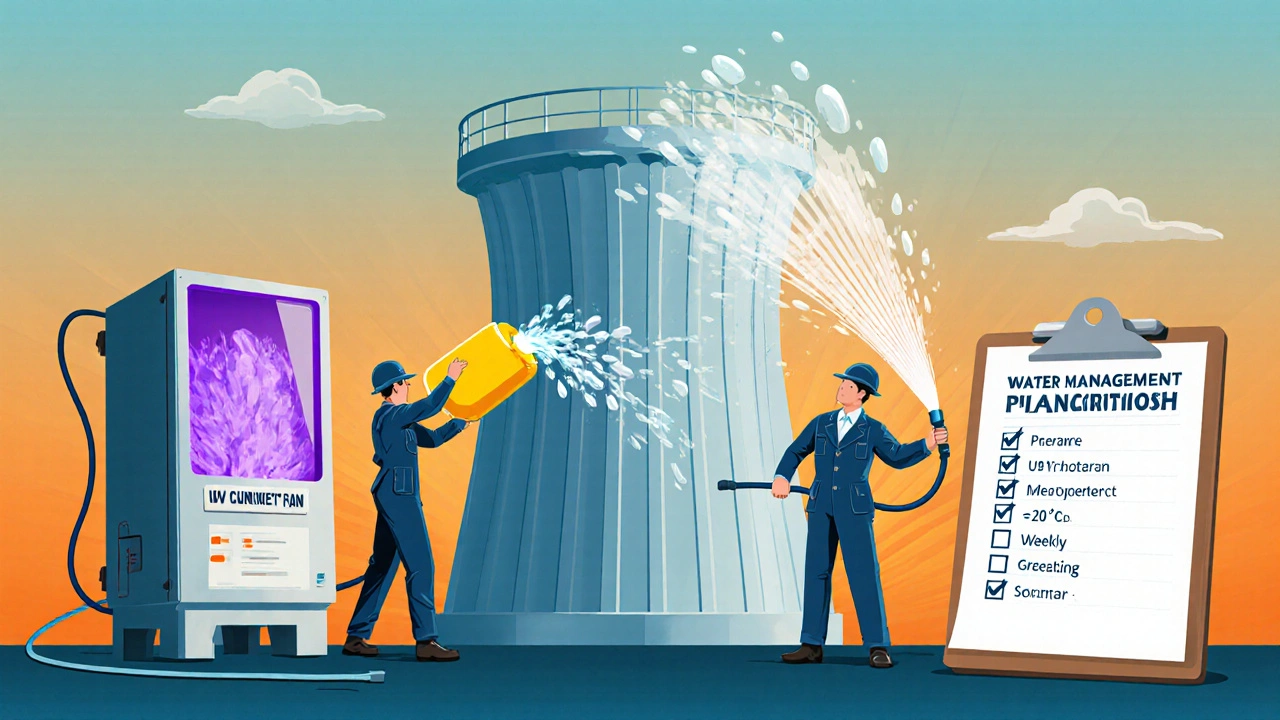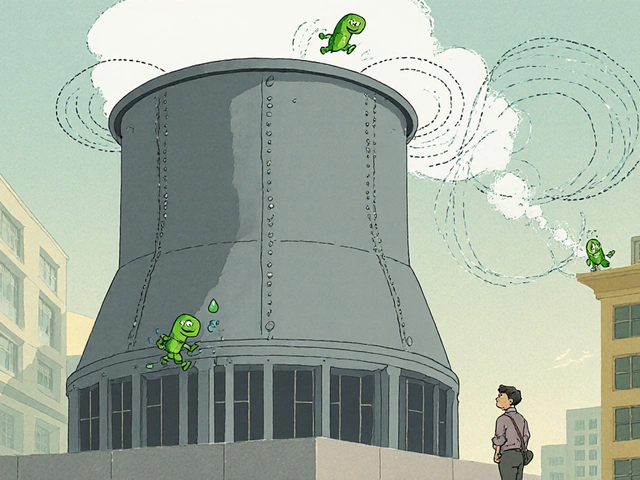Oct
19

- by Gareth Harington
- 1 Comments
Cooling Tower Risk Assessment Tool
Risk Assessment Calculator
This tool calculates the risk of Legionella contamination based on your cooling tower's water temperature and disinfectant levels.
When a building’s cooling tower starts spewing invisible droplets, the risk isn’t just a sweaty office - it can become a deadly health crisis. Legionnaire's disease spikes in cases whenever these systems aren’t kept in check, and the link between the two is stricter than most people realize.
Key Takeaways
- Legionella pneumophila thrives in warm, stagnant water found in cooling towers and other HVAC components.
- Inhalation of aerosolized water droplets is the main transmission route.
- Symptoms appear 2‑14 days after exposure and can rapidly progress to pneumonia.
- Regular water testing, proper disinfectant dosing, and a documented water‑management plan cut outbreak risk dramatically.
- Early detection hinges on sharp clinical suspicion and rapid laboratory confirmation.
What is Legionnaire's disease?
Legionnaire's disease is a severe form of pneumonia caused by the bacterium Legionella pneumophila. First identified after a 1976 convention of the American Legion in Philadelphia, the disease now accounts for 5‑10% of all community‑acquired pneumonias in many countries.
The culprit, Legionella pneumophila is a Gram‑negative rod that multiplies best between 25 °C and 45 °C, especially in biofilm‑rich water systems. Unlike many pathogens, it doesn’t spread person‑to‑person; you need to inhale contaminated droplets.
How cooling towers spread the bacteria
Cooling towers are large heat‑exchange structures that cool water by exposing it to air, producing a fine mist called an aerosol. This aerosol can travel tens of metres, easily entering nearby homes, offices, or hospitals.
When water temperatures sit around 30‑40 °C and nutrients are present, Legionella establishes colonies within the tower’s drift eliminators, basin, and piping. A single tower can release millions of viable bacteria per hour, creating what epidemiologists call a “point‑source outbreak”.

Signs, symptoms and risk factors
Typical symptoms mirror a bad flu: high fever, chills, cough (often productive), muscle aches, and shortness of breath. In severe cases, patients develop acute respiratory distress, requiring ICU care.
Key risk factors include:
- Age > 50 or chronic lung disease.
- Smoking, diabetes, or immunosuppression.
- Recent exposure to aerosol‑generating water systems (cooling towers, hot tubs, decorative fountains).
The incubation period is typically 2‑14 days, with a median of 5‑7 days. This lag often makes it hard for clinicians to link symptoms to a specific tower.
Detecting and investigating outbreaks
When a cluster of pneumonia cases appears, public health officials start an outbreak investigation. The first step is case definition-confirming each patient’s lab result shows Legionella DNA or culture.
Environmental sampling follows. Technicians collect water from suspected towers, measure temperature, and perform environmental sampling for Legionella counts (CFU/mL). The U.S. CDC recommends a threshold of 10,000 CFU/mL as a red flag for action.
In parallel, the American Society of Heating, Refrigerating and Air‑Conditioning Engineers (ASHRAE) provides guidelines (Standard 188‑2018) that outline sampling frequency, disinfectant levels, and documentation.

Prevention and control measures
The cornerstone is a written water‑management plan. It should include:
- System inventory - list every cooling tower, hot water tank, and decorative fountain.
- Risk assessment - identify parts where water stagnates or temperatures fall in the Legionella growth range.
- Control strategies - maintain temperature < 20 °C or > 60 °C, or use continuous disinfectants (chlorine ≥ 0.5 mg/L, copper‑silver ionization, monochloramine).
- Monitoring - weekly temperature checks, monthly culture or PCR tests, and quarterly verification of disinfectant residual.
- Documentation - keep logs for at least three years, ready for health‑department audits.
Physical cleaning is equally critical. Biofilm removal via high‑pressure flushing, followed by shock chlorination (3 mg/L free chlorine for 30 minutes), can reset a contaminated system.
For buildings that can’t keep water hot enough, installing UV disinfection units offers a chemical‑free barrier that inactivates bacteria as water passes through.
Case study: 2023 outbreak in Perth, Australia
In March 2023, Perth’s health department linked 12 severe pneumonia cases to a municipal cooling tower serving a large office complex. The investigation uncovered:
- Water temperature averaging 33 °C year‑round.
- Neglected quarterly testing - the last sample was taken 18 months earlier.
- Chlorine residual consistently below 0.2 mg/L.
After emergency shock chlorination and a full system overhaul, no new cases surfaced. The incident prompted Western Australia to tighten mandatory testing to every 30 days for towers larger than 30 m³.
Frequently Asked Questions
How long does Legionella survive in a cooling tower?
Legionella can persist for months if temperatures stay in the 25‑45 °C range and disinfectant levels are inadequate. Regular flushing and disinfectant dosing dramatically shorten its lifespan.
Can residential air‑conditioning units cause Legionella?
Most home split‑type AC units don’t produce aerosols, so the risk is low. However, window‑type units that draw in outside air from humid basements could theoretically spread bacteria if the source water is contaminated.
What symptoms should prompt a doctor to test for Legionella?
Fever above 38 °C, a dry or productively coughing chest, and recent exposure to a cooling tower, hot tub, or decorative fountain should trigger a urinary antigen test or sputum culture for Legionella.
Is chlorine the best disinfectant for cooling towers?
Chlorine is widely used because it’s cheap and effective, but it can degrade under sunlight. Many facilities combine chlorine with UV or copper‑silver ionization to maintain consistent kill rates.
How much does a typical water‑management plan cost?
Costs vary by building size. A small 5‑story office may spend $2,000‑$5,000 annually for testing and chemicals, while large industrial complexes can exceed $20,000. The expense is a fraction of the potential healthcare and legal costs of an outbreak.






1 Comments
Christopher Burczyk
The CDC stipulates that any cooling‑tower water sample surpassing 10,000 CFU/mL of Legionella requires immediate corrective action. This threshold is derived from epidemiological data linking such concentrations to point‑source outbreaks. Facilities that ignore this benchmark expose occupants to unnecessary mortality risk.
Write a comment